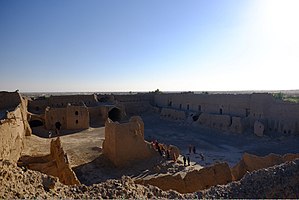| Kharan Fort خاران قلعہ | |
|---|---|
 A view of Kharan Fort | |
 | |
| General information | |
| Architectural style | Iranian |
| Location | Kharan District, Pakistan |
| Coordinates | 28°34′33″N 65°24′53″E / 28.575717°N 65.414749°E |
| Year(s) built | 19th century |
Kharan Fort (Urdu: خاران قلعہ) is a fort located in Kharan District, Balochistan, Pakistan.[1]
History[edit]
Kharan Fort was built by Azad Khan Nosherwani of Kharan in 19th century.[2][3] Azad Khan constructed eleven fortifications around the city, bolstering its defenses against potential threats from Afghanistan, the State of Kalat, and foreign traders.[1]
However, the fort's construction faced numerous water-related challenges that hindered progress.[1] Repeated attempts at well and Karez construction yielded no viable water source, rendering fort construction unfeasible.[1]
In response to these issues, a spiritual figure with ties to the chief was sought for help.[1] The spiritual guide led Azad Khan north of Kharan to Dilkasha, an eminent location at the time, where he used his mystical wand to mark the Karez and the fort's location.[1] Reports suggest that, following this intervention, the Karez water flow has remained consistent.[1]
Under the spiritual guide's influence, a new construction strategy was implemented for the fort.[1] Its design drew inspiration from Iranian architecture, utilizing sturdy burnt bricks and incorporating dome-shaped structures for added security.[1] It is believed that the fort's building materials were transported from a location approximately six kilometers away using a human chain.[1]
Architecture[edit]
The fort was built in the Iranian style, with thick burnt bricks and dome-shaped features for security purposes.[1] There was a mosque near the fort that is in ruins now.[4]
References[edit]
- ^ a b c d e f g h i j k "Kharan: A Sand Carved Citadel in a Desert". Youlin Magazine.
- ^ "The historical beauty of Balochistan". May 21, 2019.
- ^ http://web.uob.edu.pk/uob/Journals/Balochistan-Review/data/BR%2002%202015/41-60%20Archaeological%20Sites%20of%20Kharan%20and%20their%20Present%20Condition%20A%20Script%20about%20Western%20Region%20of%20Balochistan,%20Ghulam%20Farooq%20Baloch1.pdf
- ^ "قلعہ خاران کی تاریخی مسجد عدم توجہی کے باعث منہدم ہوگئی". روزنامہ آزادی | Daily Azadi, Quetta. November 11, 2016.

Well, that’s interesting to know that Psilotum nudum are known as whisk ferns. Psilotum nudum is the commoner species of the two. While the P. flaccidum is a rare species and is found in the tropical islands. Both the species are usually epiphytic in habit and grow upon tree ferns. These species may also be terrestrial and grow in humus or in the crevices of the rocks.
View the detailed Guide of Psilotum nudum: Detailed Study Of Psilotum Nudum (Whisk Fern), Classification, Anatomy, Reproduction